
The new Nexo is a significant upgrade over the first model, but will Hyundai’s fuel cell EV make an impression in the US?
Meet the new Hyundai Nexo fuel cell EV
Hyundai is launching a slate of new vehicles, ranging from EVs to plug-in hybrids (PHEVs) and even fuel-cell electric vehicles.
First launched in 2018, the Nexo marked a milestone as Hyundai’s first dedicated hydrogen fuel cell vehicle. Although it wasn’t exactly a hit due to the lack of hydrogen fueling stations, especially in the US, Hyundai is taking another crack at the market with its new and improved fuel cell EV.
Hyundai introduced the new Nexo earlier this year, claiming it’s “poised to set a new standard for zero-emission transportation.”
With significant upgrades to its fuel cell and power electronics systems, the new Nexo features up to 190 kW total output and a WLTP driving range of up to 513 miles (826 km) from a five-minute hydrogen refill.

It also boasts features such as Active Noise Control, road-noise-canceling tech, sound-absorbing tires, e-Handling, and a Smart Regenerative System (SRS), which delivers a smooth, quiet ride.
Inside, Hyundai’s new Connected Car Navigation Cockpit (ccNC) sits at the center, featuring dual 12.3″ driver cluster and infotainment screens. The setup includes OTA updates and wireless Apple CarPlay and Android Auto.

Like its battery electric vehicles, the new Nexo offers vehicle-to-load (V2L) capabilities, enabling you to power electronics on the go.
A digital center mirror and digital side mirrors are available in select markets (not the US), replacing the traditional mirrors. In addition, the European-spec version can tow up to 1,000 kg (2,200 lbs), the first fuel cell EV to offer that level of capability.
The Nexo is 4,750 mm long, 1,865 mm wide, and 1,640 mm tall, with a wheelbase of 4,750 mm, or about the size of a Honda CR-V.

Although Hyundai is committed to expanding FCEV infrastructure, it might not be enough to lure buyers in the US.
Hyundai said the new Nexo fuel cell EV is already a hit in South Korea, where hydrogen fueling stations far outnumber those in the US. The company sold nearly 7,000 new Nexo models globally through August, more than four times the previous generation’s sales in the same period last year.
Will the new and improved Nexo make a bigger impact? According to Car and Driver, which test drove the updated FCEV, “the compact Nexo will need far more than clever engineering to make it big in the US.” In Hyundai’s home market, it’s already proving more popular.
Hyundai will launch the new fuel cell EV in other global markets starting in early 2026.
Author: Peter Johnson
Source: Electrek
Reviewed By: Editorial Team



